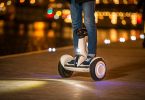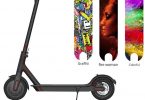My name is Phillip Gray and I love going outdoors riding on skates and scooters. I work as a graphic designer and I love creativity. This is why I appreciate the different creative scooter’s designs. I’ve been riding on kick scooters ever since I was 5 and one of my early scooters had grown-up together with me.
Can you ride a kick scooter in the rain
Riding on a kick scooter in the rain is a difficult exercise. A wet road is an obstacle-strewn road for the driver of a 2-wheeler.
To remove the rain-created water from the road, you need to be able to rely on your tires. This is why it is necessary to maintain your scooter regularly and to be particularly vigilant about the condition of the tires, especially in terms of their pressure (if pneumatic tires)
In dry weather already, white strips, sewer plates, dead leaves, or paving stones hinder your quiet driving. In wet weather, these elements become a nightmare. At the slightest sudden acceleration or the first untimely braking on one of them, you can be sure to skid.
By scooter, riding on wet roads requires you to see from a distance the obstacles on the ground that could cause you to slip. So you have to be vigilant and focused on the road! Yes, but it’s raining and if you’re soaked and/or cold-dead, don’t be too under any illusions about the attention you’re going to pay to anticipate and dodge obstacles on the road. No, you may take a much longer time to react. That’s why it’s necessary when riding a scooter in bad weather, to prepare your 2-wheel equipment well. A waterproof suit or waterproof jacket and over-pants and gloves are your best friends for driving in the rain.
At the risk of breaking open doors, be aware that in two wheels, your visibility decreases because it rains and your grip is less good because the road is wet.
Therefore, it is imperative that you:
- If your 2-wheel helmet screen doesn’t have an original fog control, consider using a fog mask or applying a fog-proof treatment inside the visor;
- For your grip, think first about driving straight, adopting a flexible ride, i.e. without sudden change of direction, acceleration, or braking, in order to avoid aquaplaning;
- Reduce your speed and lengthen safety distances.
No less than 9.5% of road accidents involve two-wheelers. Suffice to say that without a good dose of vigilance, a rider is exposed to enormous dangers especially in bad weather. While bad weather is a factor in many accidents, their main reason is the lack of precautions. This is enough to help lovers of two-wheelers to drive safely when it rains.
- Review the mechanics of your scooter
The first thing to do is to make sure your scooter is fit to withstand the weather. Brakes and suspensions must be checked and in good working order before venturing onto a wet road.
- Check the condition of the tires and wheels
It is important to ensure that the tires/wheels are properly inflated and do not show any signs of wear that would mean poor water discharge. Smooth tires should be avoided. It is advisable to change your tires as the winter season approaches by opting for tires that have a better grip on the road and better resistance.
- Adapt your driving style
You need to keep an eye on other riders and obstacles and reduce your riding speed. Use safe riding and avoid speeding or braking too abruptly. Angles and turns should also be avoided as much as possible. If your tires leave traces, you will need to slow down as this indicates a significant risk of slippage.
- Riding Tips
It is imperative to avoid obstacles of all kinds (water flakes, dead leaves, ground markings, hydrocarbon puddles, etc.) and to ride where there is the least risk of skidding. It is advisable to follow in the footsteps left by other riders without losing sight of the road around you.
Riding in bad weather mobilizes all your senses and requires a lot of energy, which is why it will be good to give you from time to time a few moments of respite to rest.
It is recommended to apply the brake gently as soon as you feel the need to limit sudden gestures. The use of the rear brake is to be preferred. Remember to leave more distance between you and the obstacles in front of you. Riding too close to it puts you at significant risk.
- Watch your position
Make sure the scooter is straight so that it rolls on the middle of the tire, which is also its warmest part. If you have to turn, go smoothly by adopting an inner swaying position where the upper part of the body will be directed inwards and downwards.
- See and be seen
Helmets can quickly find themselves inundated with water and fog, especially if it is thin. That’s why a helmet should be chosen wisely.
The screen should always be flawless in order to have a clear view. Rain sprays are available to help drain water from your visor faster.
You must also be easily discernible by other riders by having reflective nets on clothing and a yellow vest. Although not really required for scooter riders, this is mandatory on a motorcycle that can be adopted on scooters.
If the weather is particularly dark or foggy, flashlights attached to your helmet can be of great help.
- Properly equipped in rainy weather
What should you be wary of when driving in bad weather?
a.) Summer ice
After a long period of drought, a sudden rain brings back the impurities that had accumulated making the road extremely slippery. This phenomenon is known as summer ice. Slowing down is the only thing to do in this case.
b.) Ice
In addition to the summer ice, the classic cold-weather ice is a major danger for all bikers and riders. It is therefore advisable not to drive in wet and windy areas where ice tends to develop (tunnels, bridges, wood, etc.).
c.) Strong winds
Rain is often accompanied by strong winds. In this case, avoid leaning forward and ensure that you maintain the handlebars properly.
Avoid riding in the rain as much as possible, especially in stormy weather, and remember to be wary and careful because even if you take all your precautions you may be a victim of the carefree behavior of other riders and vehicles, of which they may themselves be victims. You can go to Windy or use any other program.






